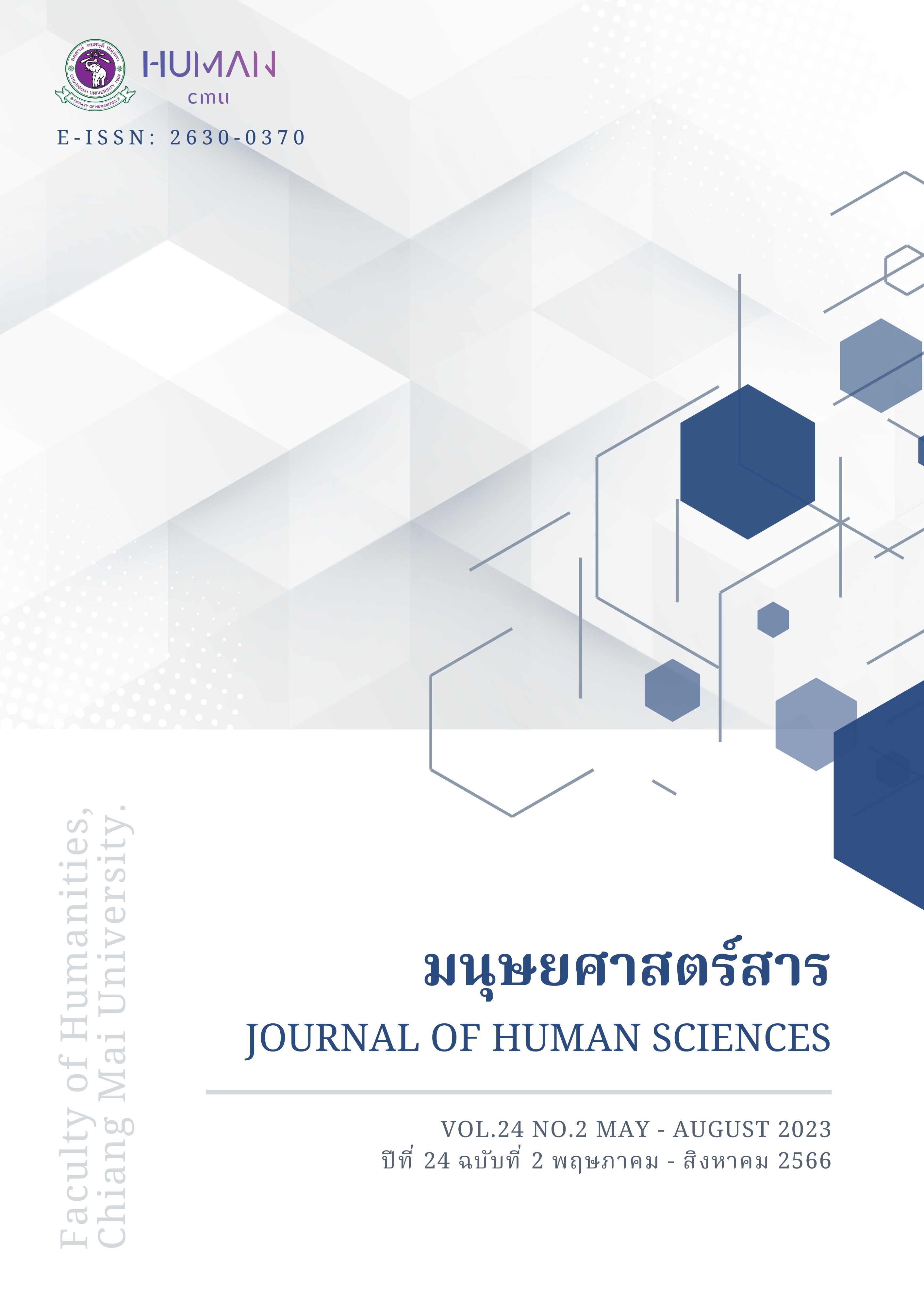การ ถ่ายทอดอุปลักษณ์เชิงมโนทัศน์และถ้อยคำอุปลักษณ์ในการแปล
Main Article Content
บทคัดย่อ
บทความวิชาการนี้มุ่งสังเคราะห์องค์ความรู้จากงานวิจัยก่อนหน้าเกี่ยวกับการถ่ายทอดอุปลักษณ์เชิงมโนทัศน์และการแปลถ้อยคำอุปลักษณ์ ตลอดจนตั้งข้อสังเกตและให้ข้อเสนอแนะสำหรับการทำวิจัยเดิมการแปลอุปลักษณ์มุ่งเน้นที่การหาถ้อยคำที่เทียบเคียงกันได้กับตัวบทภาษาต้นฉบับ แต่การศึกษารูปแบบการถ่ายทอดอุปลักษณ์เชิงมโนทัศน์จากภาษาหนึ่งไปยังอีกภาษาหนึ่งตามแนวทางอรรถศาสตร์ปริชานจะสะท้อนให้เห็นกระบวนการทางปริชานอันเกิดจากประสบการณ์ทางกายภาพของผู้ใช้ภาษา การศึกษาดังกล่าวครอบคลุมการระบุถ้อยคำอุปลักษณ์และมโนทัศน์ที่พบในภาษาต้นฉบับ การวิเคราะห์กลวิธีการถ่ายทอดมโนทัศน์และการแปลถ้อยคำอุปลักษณ์ออกมาในภาษาแปล และการเปรียบเทียบมโนทัศน์ที่เหมือนหรือแตกต่างกันระหว่างภาษาต้นฉบับและภาษาแปล บทความนี้จะเป็นพื้นฐานในการทำความเข้าใจภาษาและมโนทัศน์ผ่านการแปล ตลอดจนใช้เป็นแหล่งความรู้สำหรับการเรียนการสอนภาษาศาสตร์และการแปล
Article Details

อนุญาตภายใต้เงื่อนไข Creative Commons Attribution-NonCommercial-NoDerivatives 4.0 International License.
เอกสารอ้างอิง
จิรันธรา ศรีอุทัย. (2565). ความหมายกับการแปล. โครงการเผยแพร่ผลงานวิชาการ คณะอักษรศาสตร์ จุฬาลงกรณ์มหาวิทยาลัย.
ดิษยา สิริกิตติกร. (2560). การศึกษาเปรียบเทียบตัวบทที่มีอุปลักษณ์เชิงมโนทัศน์เกี่ยวกับธุรกิจกับบทแปล: กรณีศึกษาเรื่อง It's not about you (ยิ่งให้ยิ่งชนะ). สารนิพนธ์อักษรศาสตรมหาบัณฑิต, จุฬาลงกรณ์มหาวิทยาลัย.
นุชนารถ อุทยานสุทธิ. (2561). แนวทางการแปลคำอุปลักษณ์เชิงมโนทัศน์ในตัวบทวิชาการด้านความสัมพันธ์ระหว่างประเทศ. สารนิพนธ์อักษรศาสตรมหาบัณฑิต, จุฬาลงกรณ์มหาวิทยาลัย.
ปิยภรณ์ อบแพทย์. (2552). อุปลักษณ์เกี่ยวกับชีวิตในหนังสือธรรมะ. วิทยานิพนธ์อักษรศาสตรมหาบัณฑิต, จุฬาลงกรณ์มหาวิทยาลัย.
ภิญญาพัชญ์ รุ่งเรืองสัมฤทธิ์. (2562). การศึกษาการแปลอุปลักษณ์มโนทัศน์ในหนังสือเศรษฐศาสตร์จากภาษาอังกฤษเป็นภาษาไทย. สารนิพนธ์อักษรศาสตรมหาบัณฑิต, จุฬาลงกรณ์มหาวิทยาลัย.
วรวรรณา เพ็ชรกิจ. (2551). การศึกษาอุปลักษณ์เกี่ยวกับโรคมะเร็งในภาษาไทยตามแนวปริชานศาสตร์และวัจนปฏิบัติศาสตร์. วิทยานิพนธ์อักษรศาสตร์ดุษฎีบัณฑิต, จุฬาลงกรณ์มหาวิทยาลัย.
สุพรรณี ปิ่นมณี. (2562). ภาษา วัฒนธรรมกับการแปล: ไทย-อังกฤษ. สำนักพิมพ์แห่งจุฬาลงกรณ์มหาวิทยาลัย
อรสุรางค์ แสงสมสุรศักดิ์. (2563). โครงการวิจัยแนวทางการแปลถ้อยคำที่สะท้อนอุปลักษณ์เชิงมโนทัศน์ในตัวบทโฆษณาผลิตภัณฑ์เครื่องสำอางบนเว็บไซต์จากภาษาอังกฤษเป็นภาษาไทย. สารนิพนธ์อักษร ศาสตรมหาบัณฑิต, จุฬาลงกรณ์มหาวิทยาลัย.
อรสุรางค์ แสงสมสุรศักดิ์, และ ทองทิพย์ พูลลาภ. (2565). การแปลอุปลักษณ์เชิงมโนทัศน์ในโฆษณาผลิตภัณฑ์บำรุงผิวจากภาษาอังกฤษเป็นภาษาไทย. วารสารอักษรศาสตร์, 51(2), 91-114. https://so03.tci-thaijo.org/index.php/jletters/article/view/262041
Alshunnag, M. B. M. (2016). Translating Conceptual Metaphor in Popular Biomedical Texts from English to Arabic. [Unpublished doctoral dissertation]. University of Salford. http://usir.salford.ac.uk/id/eprint/39306/1/final%20-%20Copy%20(2).pdf
Broeck, R. v. d. (1981). The limits of translatability exemplified by metaphor translation. Poetics Today, 2(4), 73-87.
Dagut, M. (1976). Can "metaphor" be translated? Babel, 22(1), 21-33.
Deignan, A., Gabrys, D., and Solska, A. (1997). Teaching English metaphors using cross- linguistic awareness-raising activities. ELT Journal, 51(4), 352-360.
Evans, V., & Green, M. (2006). Cognitive linguistics: An introduction. Edinburgh University Press.
Fleischman, S. (2003). Language and medicine. In D. Schiffrin, D. Tannen, and H. E. Hamilton (Eds.), The Handbook of Discourse Analysis (pp. 470-502). Blackwell.
Gwyn, R. (1999). “Captain of my own ship”: Metaphor and the discourse of chronic illness. In L. Cameron, G. D. Low, (Eds.), Researching and applying metaphor (pp. 203-248. Cambridge University Press.
Kirmayer, L. (1992). The body’s insistence on meaning: Metaphor as presentation and representation in illness experience. Medical Anthropology Quarterly, 6(4), 323-346.
Knowles, M., & Moon, R. (2006). Introducing metaphor. Routledge.
Kövecses, Z. (2010). Metaphor: A practical introduction. Oxford University Press.
Lakoff, G., & Johnson, M. (1980). Metaphors we live by. University of Chicago Press.
Larson, M. L. (1984). Meaning-based translation: A guide to cross-language equivalence. University Press of America.
Mandelblit, N. (1995). The cognitive view of metaphor and its implications for translation theory. Translation and Meaning, 483-495.
Newmark, P. (1985). The translation of metaphor. In W. Paprotté, and R. Dirven, (Eds.), The ubiquity of metaphor: Metaphor in language and thought (pp. 295-326), John Benjamins.
Newmark, P. (1988). A textbook of translation. Prentice-Hall International.
Nida, E. A. (1964). Towards a science of translating. Leiden E.J. Brill.
Papadoudi, D. (2010). Conceptual Metaphor in English Popular Technology and Greek Translation. [Unpublished doctoral dissertation]. University of Manchester. https://research.manchester.ac.uk/en/studentTheses/conceptual-metaphor-in-english-popular-technology-and-greek-trans
Pragglejaz Group. (2007). Mip: A method for identifying metaphorically used words in discourse. Metaphor and Symbol, 22(1), 1–39.
Rodriguez Marquez, M. (2010). Patterns of translation of metaphor in annual reports in American English and Mexican Spanish. [Unpublished doctoral dissertation]. University of Surrey.
Ross, J. W. (1989). The militarization of disease: do we really want a war on AIDS. Sounding, 72(1), 39-58.
Schäffner, C. (2004). Metaphor and translation: some implications of a cognitive approach. Journal of Pragmatics, 36, 1253-1269.
Semino, E., Heywood, J., & Short, M. (2004). Methodological problems in the analysis of metaphors in a corpus of conversations about cancer. Journal of Pragmatics, 36(7), 1271-1294.
Stibbe, A. (1996). The metaphorical construction of illness in Chinese culture. Journal of Asian Pacific Communication, 7(3/4), 177-188.
Strik Lievers, F. (2016). Synaesthetic metaphors in translation. Studi e Saggi Linguistici, 54(1), 43-69.
Tcaciuc, L. S. 2013. Translation practices at the European Central Bank with Reference to Metaphors. [Unpublished Ph.D. thesis]. Aston University.
Toury, G. (1995). Descriptive translation studies and beyond. John Benjamins.
Yu, N. (1995). Metaphorical expressions of anger and happiness in English and Chinese. Metaphor and symbol, 10(2), 59-92.


